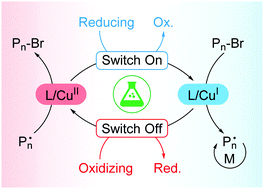Temporal control in atom transfer radical polymerization (ATRP) relies on modulating the oxidation state of a copper catalyst, as polymer chains are activated by L/CuI and deactivated by L/CuII. (Re)generation of L/CuI activator has been achieved by applying a multitude of external stimuli. However, switching the Cu catalyst off by oxidizing to L/CuII through external chemical stimuli has not yet been investigated. A redox switchable ATRP was developed in which an oxidizing agent was used to oxidize L/CuI activator to L/CuII, thus halting the polymerization. A ferrocenium salt or oxygen were used to switch off the Cu catalyst, whereas ascorbic acid was used to switch the catalyst on by (re)generating L/CuI. The redox switches efficiently modulated the oxidation state of the catalyst without sacrificing control over polymerization.
